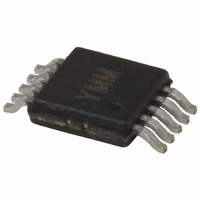MIC2174-1YMM Micrel Inc, MIC2174-1YMM Datasheet - Page 11

MIC2174-1YMM
Manufacturer Part Number
MIC2174-1YMM
Description
IC BUCK SYNC ADJ 25A 10MSOP
Manufacturer
Micrel Inc
Series
Hyper Speed Control™r
Type
Step-Down (Buck)r
Datasheet
1.MIC2174-1YMM.pdf
(27 pages)
Specifications of MIC2174-1YMM
Internal Switch(s)
No
Synchronous Rectifier
Yes
Number Of Outputs
1
Voltage - Output
0.8 ~ 5.5 V
Frequency - Switching
300kHz
Voltage - Input
3 ~ 5.5 V
Operating Temperature
-40°C ~ 125°C
Mounting Type
Surface Mount
Package / Case
10-MSOP, Micro10™, 10-uMAX, 10-uSOP
Power - Output
421mW
Primary Input Voltage
40V
No. Of Outputs
2
Output Current
25A
Voltage Regulator Case Style
MSOP
No. Of Pins
10
Operating Temperature Range
-40°C To +125°C
Svhc
No SVHC (15-Dec-2010)
Lead Free Status / RoHS Status
Lead free / RoHS Compliant
Current - Output
-
Lead Free Status / RoHS Status
Lead free / RoHS Compliant, Lead free / RoHS Compliant
Other names
576-3546-5
Available stocks
Company
Part Number
Manufacturer
Quantity
Price
Company:
Part Number:
MIC2174-1YMM
Manufacturer:
Micrel Inc
Quantity:
135
Micrel, Inc.
Functional Description
The
synchronous buck controller built for low cost and high
performance. It is designed for a wide input voltage
range from 3V to 40V and for high output power buck
converters. An estimated-ON-time method is applied in
MIC2174/MIC2174C to obtain a constant switching
frequency and to simplify the control compensation. The
over-current protection is implemented without the use of
an external sense resistor. It includes an internal soft-
start function which reduces the power supply input
surge current at start-up by controlling the output voltage
rise time.
Theory of Operation
The
synchronous buck controller. Further, Figure 1 illustrates
the block diagram for the control loop. The output
voltage
MIC2174/MIC2174C feedback pin FB via the voltage
divider R1 and R2, and compared to a 0.8V reference
voltage V
transconductance (gm) amplifier, which improves the
MIC2174/MIC2174C converter output voltage regulation.
If the FB voltage decreases and the output of the gm
amplifier is below 0.8V, then the error comparator will
trigger the control logic and generate an ON-time period,
where in DH pin is logic high and DL pin is logic low. The
ON-time period length is predetermined by the “FIXED
T
where V
stage input voltage.
After an ON-time period, the MIC2174/MIC2174C goes
into the OFF-time period. This is when the DH pin is
logic low and DL pin is logic high. The OFF-time period
length depends upon the FB voltage in most cases.
When the FB voltage decreases and the output of the
gm amplifier is below 0.8V, then the ON-time period is
triggered and the OFF-time period ends. If the OFF-time
period determined by the FB voltage is less than the
minimum OFF time T
typical, then the MIC2174/MIC2174C control logic will
apply the T
maintain enough energy in the Boost capacitor (C
drive the high-side MOSFET.
September 2010
ON
ESTIMATION” circuitry:
MIC2174/MIC2174C
MIC2174/MIC2174C
T
OUT
REF
ON(estimat
variation
at the error comparator through a low gain
is the output voltage, V
OFF(min)
ed)
=
instead. T
V
will
OFF(min)
HSD
V
×
OUT
is
is
300kHz
be
, which is about 363ns
OFF(min)
an
an
sensed
adaptive
adaptive
HSD
is required to
is the power
by
on-time
on-time
BST
) to
the
(1)
11
The maximum duty cycle is obtained from the 363ns
T
where Ts = 1/300kHz = 3.33μs. It is not recommended to
use MIC2174/MIC2174C with a OFF-time close to
T
increases, the internal ripple injection will increase and
reduce the line regulation performance. Therefore, the
maximum output voltage of the MIC2174 should be
limited to 5.5V for up to 28V V
higher than 28V. If a higher output voltage is required,
use the MIC2176 instead. Please refer to “Setting Output
Voltage” subsection in “Application Information” for more
details.
The power stage input voltage V
T
voltage clamper. Therefore, if the V
30V, then the Fixed T
estimate T
switching frequency will be less than 300kHz:
The estimated ON-time method results in a constant
300kHz switching frequency up to 30V V
ON-time varies with the different rising and falling times
of the external MOSFETs. Therefore, the type of the
external MOSFETs, the output load current, and the
control circuitry power supply V
ON-time and the switching frequency. Also, the minimum
T
and low V
minimum T
evaluation board with Si7148DP MOSFETs is about
184ns. During the load transient, the switching frequency
is changed due to the varying OFF time.
To illustrate the control loop, the steady-state scenario
and the load transient scenario are analyzed. For easy
analysis, the gain of the gm amplifier is assumed to be 1.
With this assumption, the inverting input of the error
comparator is the same as the FB voltage. Figure 2
shows the MIC2174/MIC2174C control loop timing
during steady-state operation. During steady-state, the
gm amplifier senses the FB voltage ripple, which is
proportional to the output voltage ripple and the inductor
current ripple, to trigger the ON-time period. The ON-
time is predetermined by the estimation. The ending of
OFF-time is controlled by the FB voltage. At the valley of
OFF(min)
OFF(min)
ON
ON
results in a lower switching frequency in high V
Estimation block through a 6:1 divider and 5V
:
Dmax
f
during steady-state operation. Also, as V
SW(VHDS
ON
OUT
ON
instead of the real V
=
applications, such as 36V to 1.0V. The
>
measured on the MIC2174/MIC2174C
30V)
T
S
−
=
T
T
V
30V
ON
OFF(min)
S
HSD
Estimation block uses 30V to
×
300kHz
=
IN
HSD
1
HSD
MIC2174/MIC2174C
−
will modify the actual
HSD
is fed into the Fixed
363ns
and 3.6V for V
HSD
T
. As a result, the
M9999-091310-C
S
HSD
is higher than
. The actual
OUT
HSD
HSD
(2)












